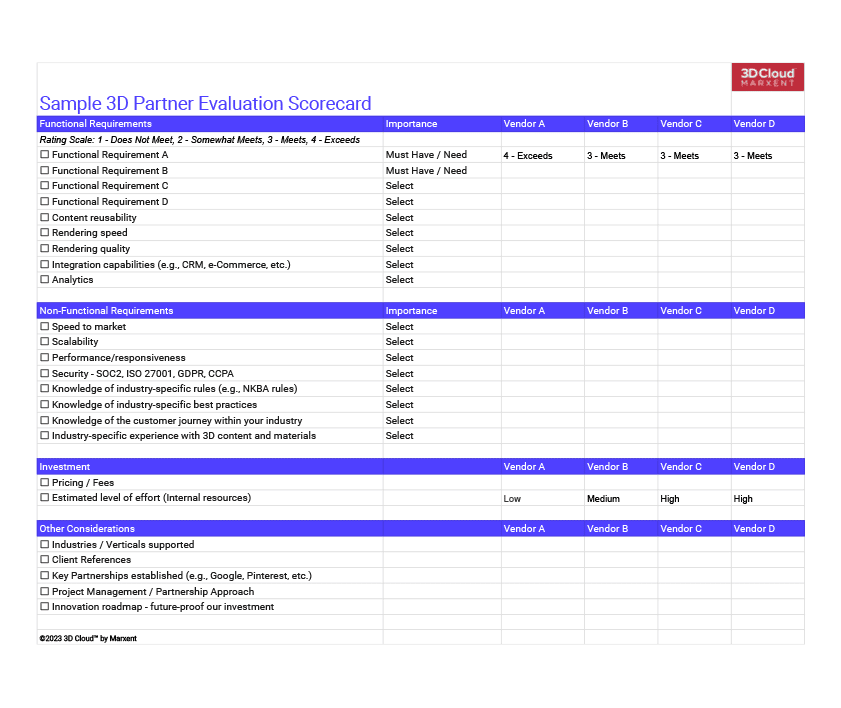Download PDF Template
Download Excel Template | Download Google Sheets Template
3D vendor selection can be complicated. Use this system and our free 3D Vendor Evaluation Scorecard Template to ensure that you are making the best choice for your organization. The scorecard framework will help you to make a clear decision, then support and defend it objectively.
This article covers:
- A framework for evaluating 3D vendor capabilities
- Key questions to ask before selecting a 3D vendor
- FREE TEMPLATE: 3D Vendor Evaluation Scorecard
If you are a project leader working on a strategic 3D initiative, this article is for you.
Getting started with vendor evaluation
The best way to start a vendor evaluation process is with a prioritized list of requirements. Seeing vendors through the lens of what is most valuable to your organization is critical to choosing the right partner.
Evaluating vendors based on functional and non-functional requirements
Use documents like a 3D Project Charter or RFP to help capture and prioritize the functional and non-functional requirements and add these to your scorecard. Functional requirements describe required application or platform features, capabilities, and integrations. Examples of functional requirements are:
- Manage 500+ product SKUs
- Display on popular web browsers on desktop, mobile web (iOS, Android)
- Support for business rules (e.g., NKBA rules and regulations)
- Define and maintain configuration rules and logic (self-serve)
- Allow end users to dynamically customize a product based on their component choices
- CRM platform integration with a specific platform (e.g., Salesforce integration)
Non-functional requirements describe other qualities or attributes that should inherently exist in a given platform or application. Examples of non-functional requirements are:
- Availability (e.g., 99.99% uptime)
- Speed and performance
- Security and privacy
- Usability – low code application
- Ease of installation
Define needs vs. wants vs. preferences
Once the functional and non-functional requirements have been outlined, it’s time to prioritize and narrow the field. Start with non-negotiable needs. These are the requirements that must be delivered in order to achieve the desired outcomes for the project. Everything else should be categorized as a want or a preference. Once core needs are defined, work your way down the list of requirements and rate the vendors on each requirement.
Keep in mind; different vendors may use different approaches to deliver on a given requirement. Focus on the outcomes while remaining adaptable and flexible to a range of approaches.
Key questions to ask during the vendor evaluation process
Now that you have clearly defined the functional and non-functional requirements, you’ll want to ask questions about scalability, case studies, customer references, roles and responsibilities, value creation, proven return on investment, and partnership values.
Scalability
Unless you are running a one-time campaign, It’s important to plan for growth within your 3D strategy. As 3D technologies continue to evolve, the move from 2D commerce to 3D commerce will accelerate, and retailers will need to adapt quickly while containing content costs. Take time to explore whether your potential 3D vendor partners will be able to scale to meet the needs of your organization over time. Start by deciding whether you need a single use case point solution or a vendor who can support multiple use cases.
This is something that often gets overlooked because of a greater emphasis on the short-term tactical need vs. a holistic 3D vision and strategy. It’s important to have your eyes on both the short- and long-term vision and strategy for 3D in your organization.
Questions to ask:
- Can the 3D vendor extend beyond a single 3D application so that you’re not limited in the reuse of content?
- Can the 3D platform scale as new use cases for 3D content emerge?
- Is there interoperability within 3D experiences and applications to further drive your customer’s buying journey (e.g., Product Configuration with WebAR to view their personalized product in their space before purchasing)?
- Are there additional functions in your organization that may benefit from 3D capabilities, which in turn can become part of your roadmap for enterprise-wide scalability with 3D?
Case studies and customer references
There is significant value in working with those who have demonstrated expertise within your industry. Research vendor clients, ask to see the live applications, read case studies, and request references. References provide invaluable access to a customer’s viewpoint about their overall experience, from implementation to customer success. It’s also useful to tap sources like Capterra for customer reviews.
Roles and responsibilities
Part of evaluating vendors is evaluating your own internal project resources. Some vendors may be more expensive but do it all, some may cost less but provide limited service and more in-house staff to manage a project. As you assess vendors, get clear on the project roles needed from your organization and the estimated level of effort required from your in-house team.
Value creation
3D is an investment, and while cost is always a factor in choosing a vendor, it isn’t the only consideration. If you are looking for specific outcomes, find a vendor that is committed to helping you achieve your business objectives, not just handing off a software license.
For example:
- Does the vendor provide insights and analytics that help you measure ROI and optimize the application?
- Do they have a Partner Success program that provides best practices and/or learning from others who have gone before you?
- How does the provider stay ahead of the innovation curve on behalf of its clients?
- Do they have a robust innovation roadmap that is believable and achievable?
- How much influence do you, as a customer, have on the product roadmap?
Partnership
How a vendor treats you during the sales process is a good indicator of how the company will handle your project. Here are some questions you can reflect on to help evaluate the type of partnership you can expect from a vendor.
- Was every interaction a sales pitch, or was there value added throughout the process?
- Do you feel that the relationship with a prospective vendor is transactional, or do you sense that they walk the talk of partnership?
- What happens after the project is completed? Is there ongoing communication that you can expect as a client?
- When an issue arises, will they be there for you and work with you to ensure the best possible outcome for your organization?
Free Template:
We have prepared a template to help you frame your decision and compare proposals you have received in the course of meeting with different vendors. Utilize other project documentation, such as a 3D business case or 3D project charter, as a shortcut to creating a solid list of requirements.
Download the 3D Vendor Evaluation Scorecard
Download PDF Template
Download Excel Template | Download Google Sheets Template

Once you’ve evaluated vendors, what’s next?
After you’ve completed the 3D vendor evaluation process, it’s time to start aligning internal resources for your 3D project.
For a complete guide to launching a 3D project, visit our 3D Project Planning Resource Center or contact us to request a 3D project consultation.













